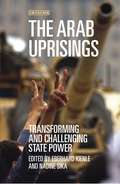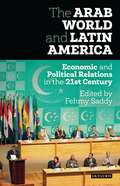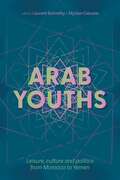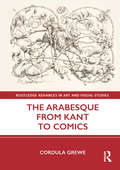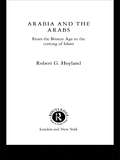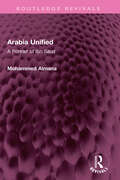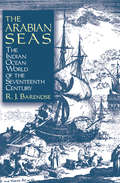- Table View
- List View
The Arab Uprisings: What Everyone Needs to Know® (What Everyone Needs To Know®)
by James GelvinEmploying an engaging question-and-answer format, The Arab Uprisings explores the revolutionary protests that have rocked the Arab world since late 2010. In this updated and revised second edition, James L. Gelvin explores the varied paths taken by the uprisings and assesses their historical and global significance. Gelvin begins with an overview-What were the conditions in the Arab world that led to the uprisings? Where did the demands for human and democratic rights and social and economic justice come from?-before turning to specific countries in the region. He examines how the long history of state-building in Tunisia and Egypt ultimately determined the paths taken by uprisings there. He explains why the weakness of state institutions in Libya and Yemen led to violence and chaos. He explores the commonalities of the "coup-proofed" states Bahrain and Syria and the tragic course of their uprisings. In the final chapter, he discusses the implications of the uprisings. What do they mean for the United States, al-Qaeda, and the balance of power in the region? What do they say about the viability of the Arab state system? What effects have they had on the Israel-Palestine conflict? What conclusions might we draw from the uprisings so far? When will we know their historical meaning? What Everyone Needs to Know® is a registered trademark of Oxford University Press.
The Arab Uprisings: Transforming and Challenging State Power (Library of Modern Middle East Studies)
by Nadine Sika Eberhard KienleThe uprisings which spread across the Middle East and North Africa in late 2010 and 2011 irrevocably altered the way in which the region is now perceived. But in spite of the numerous similarities in these protests, from Tunisia and Egypt to Yemen and Bahrain, their broader political effects display important differences. This book analyses these popular uprisings, as well as other forms of protest, and the impact they had on each state. Why were Mubarak and Bin Ali ousted relatively peacefully in Egypt and Tunisia, while Qadafi in Libya and Saleh in Yemen fought violent battles against their opponents? Why do political transformations differ in countries that were able to shed their autocratic presidents? And why have other regimes, including Morocco and Saudi Arabia, experienced only limited protests or managed to repress and circumvent them? Looking at the aftermath and transitional processes across the region, this book is a vital retrospective examination of the uprisings and how they can be understood in the light of state formation and governmental dynamics.
The Arab Winter: A Tragedy
by Noah FeldmanWhy the conventional wisdom about the Arab Spring is wrongThe Arab Spring promised to end dictatorship and bring self-government to people across the Middle East. Yet everywhere except Tunisia it led to either renewed dictatorship, civil war, extremist terror, or all three. In The Arab Winter, Noah Feldman argues that the Arab Spring was nevertheless not an unmitigated failure, much less an inevitable one. Rather, it was a noble, tragic series of events in which, for the first time in recent Middle Eastern history, Arabic-speaking peoples took free, collective political action as they sought to achieve self-determination.Focusing on the Egyptian revolution and counterrevolution, the Syrian civil war, the rise and fall of ISIS in Syria and Iraq, and the Tunisian struggle toward Islamic constitutionalism, Feldman provides an original account of the political consequences of the Arab Spring, including the reaffirmation of pan-Arab identity, the devastation of Arab nationalisms, and the death of political Islam with the collapse of ISIS. He also challenges commentators who say that the Arab Spring was never truly transformative, that Arab popular self-determination was a mirage, and even that Arabs or Muslims are less capable of democracy than other peoples.Above all, The Arab Winter shows that we must not let the tragic outcome of the Arab Spring disguise its inherent human worth. People whose political lives had been determined from the outside tried, and for a time succeeded, in making politics for themselves. That this did not result in constitutional democracy or a better life for most of those affected doesn't mean the effort didn't matter. To the contrary, it matters for history—and it matters for the future.
The Arab World and Latin America: Economic and Political Relations in the Twenty-First Century (Library of International Relations)
by Fehmy SaddyWith the growing importance of emerging markets the focus of analysts has begun to concentrate on the contribution of Latin America and the Middle East to the global economy, and the relations between these two regions. This has become ever more important with the trend in Latin America to diversify their trade relations and establish closer economic and political ties with other emerging economies, including the Middle East and North African (MENA) countries. The Arab World and Latin America examines the relations between these two regions, highlighting the often-overlooked cultural similarities, as well as exploring the political and economic ties that are being developed. As relations with and between countries in the Global South become ever more important for trade and investment, both politically and economically, this volume offers vital analyses for researchers of international relations as well as the politics and culture of the Middle East and Latin America.
The Arab World and Western Intelligence: Analysing the Middle East, 1956-1981 (Intelligence, Surveillance and Secret Warfare)
by Dina RezkThis book addresses a critical question embedded within a heated debate about American intelligence after 9/11: have Western experts failed in some fundamental way to understand the dynamics, leaders and culture of the Middle East? Using the most recently declassified documents, interviews and Arabic sources, the book examines seminal case studies culminating in Sadat’s dramatic assassination and explores how the most knowledgeable and powerful intelligence agencies in the world have been so notoriously caught off guard in this region.
The Arab World and Western Intelligence: Analysing the Middle East, 1956-1981 (Intelligence, Surveillance and Secret Warfare)
by Dina RezkThis book addresses a critical question embedded within a heated debate about American intelligence after 9/11: have Western experts failed in some fundamental way to understand the dynamics, leaders and culture of the Middle East? Using the most recently declassified documents, interviews and Arabic sources, the book examines seminal case studies culminating in Sadat’s dramatic assassination and explores how the most knowledgeable and powerful intelligence agencies in the world have been so notoriously caught off guard in this region.
The Arab Writer in English: Arab Themes in a Metropolitan Language, 1908-1958
by Geoffrey NashThis book looks at the first generation of Arab British and Arab-American writers to produce English writings in the earlier twentieth-century: Ameen Rihani, Khalil Jibran, George Antonius and Edward Atiyah. It theorises their work within the context of Arab nationalism, postcolonialism and the criticism of Edward Said.
Arab youths: Leisure, culture and politics from Morocco to Yemen
by Laurent Bonnefoy and Myriam CatusseYoung Arabs are too often reduced to the figures of the potential terrorist, the migrant or the exotic icon of the revolution. But the reality is much richer.Coming from both sides of the Mediterranean, the researchers in this book travel off the beaten track by exploring how young Arabs spend their free time. The case studies take in a wide range of countries, including Morocco, Egypt, Syria, Iraq and Saudi Arabia, and all manner of activities, from football to rap music, café culture to sex work. Drawn with sensitivity and humour, Arab youths presents an exceptional portrait of a generation that is much talked about but rarely listened to.This book gives a voice to young men and women who, as heirs of plural traditions, animated by new ideas and influenced by various cultural movements, are inventing the future of their societies in the midst of radical change.
Arabella: Gossip, scandal and an unforgettable Regency romance (Regency Romances Ser. #9)
by Georgette HeyerIf you love Bridgerton, you'll love Georgette Heyer!'The greatest writer who ever lived' Antonia Fraser'Absolutely delicious tales of Regency heroes . . . Utter, immersive escapism' Sophie Kinsella'One of my perennial comfort authors. Heyer's books are as incisively witty and quietly subversive as any of Jane Austen's' Joanne Harris_____________A fiery debutante. An ill-tempered bachelor. A romance for the ages . . .Arabella, the daughter of an impoverished country parson, dreams of a new life in London. But her beauty and charm will only get her so far - and when Arabella embarks on her first London season armed with nothing but a benevolent godmother and her own notoriously short temper, she quickly runs afoul of Robert Beaumaris.He's the most eligible bachelor of the day, with a personality as strong and combative as hers - and Arabella cannot abide him thinking of her as just another pretty girl after his wealth. So she allows herself to be provoked into a game of deception - one that could have unexpected consequences . . .Arabella is a rich, dashing romance from Georgette Heyer, the legendary creator of the beloved Regency romance genre._____________'Wonderful characters . . . rapturously romantic' Katie Fforde'A wonderful wit . . . I've read her over and over and over again' Stephen Fry'Triumphantly good . . . Georgette Heyer is unbeatable' India Knight_____________Readers love Arabella . . .***** 'An absolutely fantastic read'***** 'A true Regency romance classic'***** 'Enjoyed this book so much I read it again.'***** 'I absolutely loved it!'***** 'Kept me wholly entertained and engrossed.'
Arabella Boxer's Book of English Food: A Rediscovery of British Food From Before the War
by Arabella BoxerA Book of English Food is an elegant compendium of brilliant recipes adapted from the cookery books of the 1920s and 1930s by Arabella Boxer, with beautiful new illustrations by Cressida Bell.Arabella Boxer's Book of English Food describes the delicious dishes - and the social conditions in which they were prepared, cooked and eaten - in the short span between the two World Wars when English cooking suddenly blossomed.The food in these wonderful recipes comes from the great country houses, where little had changed since Victorian times, the large houses in London and the South, where fashionable hostesses vied with each other to entertain the most distinguished guests at their tables, and less grand establishments, like those in Bloomsbury where the painters and writers of the day contrived to lead cultured and civilised lives on little money.Containing 200 recipes, drawn from cookery books, magazines of the period, family sources or from talking to survivors who still remember those days, A Book of English Food is a fascinating glimpse into another world, and a celebration of English cooking at its finest.'That rare thing, a cookery book with an argument: viz, that English cookery was once both good and independent of the cuisines of her neighbours . . . a rollicking good read' Observer'I still find the calm elegance of her writing an inspiration' Nigel Slater'A treasury of social gossip . . . immensely enjoyable and useful' Spectator'A captivating exploration and celebration of the flowering of English cooking in the 1920s and 30s' Financial Times'I recommend it, not only for its excellent food but also for the superb introductions and details of social history in the great houses with their shimmering hostesses' Evening StandardArabella Boxer was born in 1934 and educated in the UK, Paris and Rome. She has written for the Sunday Times magazine and the Telegraph magazine and was Food Writer for Vogue from 1966 to 1968 and 1975 to 1991. She was awarded the Glenfiddich Cookery Writer of the Year Award in 1975 and 1978, a Glenfiddich Special Award in 1992 and won the 1991 André Simon Award and the 1992 Michael Smith Macallan Award for fine writing about British food. Arabella Boxer is the author of a number of cookery books, including First Slice Your Cookbook, Arabella Boxer's Garden Cookbook, Mediterranean Cookbook, The Sunday Times Complete Cookbook and A Visual Feast (with Tessa Traeger). A founding member of the Guild of Food Writers, she lives in London.
The Arabesque from Kant to Comics (Routledge Advances in Art and Visual Studies)
by Cordula GreweThe Arabesque from Kant to Comics tracks the life and afterlife of the arabesque in its surprising transformation from an iconoclastic literary theory of early German Romanticism to aesthetic experimentation in both avant-garde art and popular culture. Its explosive growth in popularity was followed by an inevitable taming as arabesques became staples in book illustration, poetry publications, and even the decoration of printed scores. The subversive potential of the arabesque was preserved in one of its most surprising offspring, the comic strip: born at the moment when the cholera pandemic first swept through Europe, the comic translated the arabesque’s rank growth into unnerving lawlessness and sequences of contagious visual slapstick. Focusing roughly on the period between 1780 and 1880, this book illuminates the intersecting histories of avant-garde theories of writing, visual culture, and even the disciplinary origins of art history. In the process, it explores media history and intermediality, social networks and cultural transfer, as well as the rise of new and nontraditional art forms. This book will be of particular interest to scholars of art history, intellectual history, European art, aesthetics, book illustration, material culture, reproduction, comics, and German history.
The Arabesque from Kant to Comics (Routledge Advances in Art and Visual Studies)
by Cordula GreweThe Arabesque from Kant to Comics tracks the life and afterlife of the arabesque in its surprising transformation from an iconoclastic literary theory of early German Romanticism to aesthetic experimentation in both avant-garde art and popular culture. Its explosive growth in popularity was followed by an inevitable taming as arabesques became staples in book illustration, poetry publications, and even the decoration of printed scores. The subversive potential of the arabesque was preserved in one of its most surprising offspring, the comic strip: born at the moment when the cholera pandemic first swept through Europe, the comic translated the arabesque’s rank growth into unnerving lawlessness and sequences of contagious visual slapstick. Focusing roughly on the period between 1780 and 1880, this book illuminates the intersecting histories of avant-garde theories of writing, visual culture, and even the disciplinary origins of art history. In the process, it explores media history and intermediality, social networks and cultural transfer, as well as the rise of new and nontraditional art forms. This book will be of particular interest to scholars of art history, intellectual history, European art, aesthetics, book illustration, material culture, reproduction, comics, and German history.
Arabesque without End: Across Music and the Arts, from Faust to Shahrazad (Music and Visual Culture)
by Anne LeonardFeaturing multidisciplinary research by an international team of leading scholars, this volume addresses the contested aspects of arabesque while exploring its penchant for crossing artistic and cultural boundaries to create new forms. Enthusiastically imported from its Near Eastern sources by European artists, the freely flowing line known as arabesque is a recognizable motif across the arts of painting, music, dance, and literature. From the German Romantics to the Art Nouveau artists, and from Debussy’s compositions to the serpentine choreographies of Loïe Fuller, the chapters in this volume bring together cross-disciplinary perspectives to understand the arabesque across both art historical and musicological discourses.
Arabesque without End: Across Music and the Arts, from Faust to Shahrazad (Music and Visual Culture)
Featuring multidisciplinary research by an international team of leading scholars, this volume addresses the contested aspects of arabesque while exploring its penchant for crossing artistic and cultural boundaries to create new forms. Enthusiastically imported from its Near Eastern sources by European artists, the freely flowing line known as arabesque is a recognizable motif across the arts of painting, music, dance, and literature. From the German Romantics to the Art Nouveau artists, and from Debussy’s compositions to the serpentine choreographies of Loïe Fuller, the chapters in this volume bring together cross-disciplinary perspectives to understand the arabesque across both art historical and musicological discourses.
Arabia and the Arabs: From the Bronze Age to the Coming of Islam
by Robert G. HoylandLong before Muhammed preached the religion of Islam, the inhabitants of his native Arabia had played an important role in world history as both merchants and warriorsArabia and the Arabs provides the only up-to-date, one-volume survey of the region and its peoples, from prehistory to the coming of IslamUsing a wide range of sources - inscriptions, poetry, histories, and archaeological evidence - Robert Hoyland explores the main cultural areas of Arabia, from ancient Sheba in the south, to the deserts and oases of the north. He then examines the major themes of*the economy*society*religion*art, architecture and artefacts*language and literature*Arabhood and ArabisationThe volume is illustrated with more than 50 photographs, drawings and maps.
Arabia and the Arabs: From the Bronze Age to the Coming of Islam
by Robert G. HoylandLong before Muhammed preached the religion of Islam, the inhabitants of his native Arabia had played an important role in world history as both merchants and warriorsArabia and the Arabs provides the only up-to-date, one-volume survey of the region and its peoples, from prehistory to the coming of IslamUsing a wide range of sources - inscriptions, poetry, histories, and archaeological evidence - Robert Hoyland explores the main cultural areas of Arabia, from ancient Sheba in the south, to the deserts and oases of the north. He then examines the major themes of*the economy*society*religion*art, architecture and artefacts*language and literature*Arabhood and ArabisationThe volume is illustrated with more than 50 photographs, drawings and maps.
Arabia Unified: A Portrait of Ibn Saud (Routledge Revivals)
by Mohammed AlmanaFirst Published in 1980 Arabia Unified presents an insider’s view of Saudi Arabia’s history and the remarkable career of its founder. The book covers the capture of Riyadh from the Saud family’s greatest rivals, the Rashid’s, and the eventual defeat of Al Rashid at the battle of Rowdhat Muhanna; the elimination of Ibn Saud’s most implacable enemies; the incorporation of the provinces of Asir and Hejaz into the kingdom; and the rise, rebellion, and eventual defeat of the puritanical Ikhwan tribesmen. Author describes life with the King’s Bedouin warriors and the intricacies of the Arabian tribal system; the confrontation with the Imam Yahya of the Yemen; and finally, the start of the oil exploration which was to transform the country. The author concludes with his own account of the King’s character and achievements. Full of humor, anecdote and reminiscence, an accurate and personal record, this book is essential reading for all who wish to know about the history of Saudi Arabia.
Arabia Unified: A Portrait of Ibn Saud (Routledge Revivals)
by Mohammed AlmanaFirst Published in 1980 Arabia Unified presents an insider’s view of Saudi Arabia’s history and the remarkable career of its founder. The book covers the capture of Riyadh from the Saud family’s greatest rivals, the Rashid’s, and the eventual defeat of Al Rashid at the battle of Rowdhat Muhanna; the elimination of Ibn Saud’s most implacable enemies; the incorporation of the provinces of Asir and Hejaz into the kingdom; and the rise, rebellion, and eventual defeat of the puritanical Ikhwan tribesmen. Author describes life with the King’s Bedouin warriors and the intricacies of the Arabian tribal system; the confrontation with the Imam Yahya of the Yemen; and finally, the start of the oil exploration which was to transform the country. The author concludes with his own account of the King’s character and achievements. Full of humor, anecdote and reminiscence, an accurate and personal record, this book is essential reading for all who wish to know about the history of Saudi Arabia.
The Arabian Desert in English Travel Writing Since 1950: A Barren Legacy? (Routledge Research in Travel Writing)
by Jenny WalkerBroadly this book is about the Arabian desert as the locus of exploration by a long tradition of British travellers that includes T.E. Lawrence and Wilfred Thesiger; more specifically, it is about those who, since 1950, have followed in their literary footsteps. In analysing modern works covering a land greater than the sum of its geographical parts, the discussion identifies outmoded tropes that continue to impinge upon the perception of the Middle East today while recognising that the laboured binaries of "East and West", "desert and sown", "noble and savage" have outrun their course. Where, however, only a barren legacy of latent Orientalism may have been expected, the author finds instead a rich seam of writing that exhibits diversity of purpose and insight contributing to contemporary discussions on travel and tourism, intercultural representation and environmental awareness. By addressing a lack of scholarly attention towards recent additions to the genre, this study illustrates for the benefit of students of travel literature, or indeed anyone interested in "Arabia", how desert writing, under the emerging configurations of globalisation, postcolonialism and ecocriticism, acts as a microcosm of the kinds of ethical and emotional dilemmas confronting today’s travel writers in the world’s most extreme regions.
The Arabian Desert in English Travel Writing Since 1950: A Barren Legacy? (Routledge Research in Travel Writing)
by Jenny WalkerBroadly this book is about the Arabian desert as the locus of exploration by a long tradition of British travellers that includes T.E. Lawrence and Wilfred Thesiger; more specifically, it is about those who, since 1950, have followed in their literary footsteps. In analysing modern works covering a land greater than the sum of its geographical parts, the discussion identifies outmoded tropes that continue to impinge upon the perception of the Middle East today while recognising that the laboured binaries of "East and West", "desert and sown", "noble and savage" have outrun their course. Where, however, only a barren legacy of latent Orientalism may have been expected, the author finds instead a rich seam of writing that exhibits diversity of purpose and insight contributing to contemporary discussions on travel and tourism, intercultural representation and environmental awareness. By addressing a lack of scholarly attention towards recent additions to the genre, this study illustrates for the benefit of students of travel literature, or indeed anyone interested in "Arabia", how desert writing, under the emerging configurations of globalisation, postcolonialism and ecocriticism, acts as a microcosm of the kinds of ethical and emotional dilemmas confronting today’s travel writers in the world’s most extreme regions.
Arabian Drugs in Medieval Mediterranean Medicine (Edinburgh Studies in Classical Islamic History and Culture)
by Zohar Amar Efraim LevFor more than one thousand years Arab medicine held sway in the ancient world, from the shores of Spain in the West to China, India and Sri Lanka (Ceylon) in the East. This book explores the impact of Greek (as well as Indian and Persian) medical heritage on the evolution of Arab medicine and pharmacology, investigating it from the perspective of materia medica – a reliable indication of the contribution of this medical legacy. Focusing on the main substances introduced and traded by the Arabs in the medieval Mediterranean – including Ambergris, camphor, musk, myrobalan, nutmeg, sandalwood and turmeric – the authors show how they enriched the existing inventory of drugs influenced by Galenic-Arab pharmacology. Further, they look at how these substances merged with the development and distribution of new technologies and industries that evolved in the Middle Ages such as textiles, paper, dyeing and tanning, and with the new trends, demands and fashions regarding spices, perfumes, ornaments (gemstones) and foodstuffs some of which can be found in our modern-day food basket.
Arabian Drugs in Medieval Mediterranean Medicine (Edinburgh Studies in Classical Islamic History and Culture)
by Zohar Amar Efraim LevFor more than one thousand years Arab medicine held sway in the ancient world, from the shores of Spain in the West to China, India and Sri Lanka (Ceylon) in the East. This book explores the impact of Greek (as well as Indian and Persian) medical heritage on the evolution of Arab medicine and pharmacology, investigating it from the perspective of materia medica – a reliable indication of the contribution of this medical legacy. Focusing on the main substances introduced and traded by the Arabs in the medieval Mediterranean – including Ambergris, camphor, musk, myrobalan, nutmeg, sandalwood and turmeric – the authors show how they enriched the existing inventory of drugs influenced by Galenic-Arab pharmacology. Further, they look at how these substances merged with the development and distribution of new technologies and industries that evolved in the Middle Ages such as textiles, paper, dyeing and tanning, and with the new trends, demands and fashions regarding spices, perfumes, ornaments (gemstones) and foodstuffs some of which can be found in our modern-day food basket.
The Arabian Nights: A Companion (Studies In The Arcadian Library)
by Robert IrwinA generous and erudite book...We're in the company of someone who loves The Arabian Nights, and who has generously shared that love with us through this companion.' - Michele Roberts, Independent on Sunday'Superlative...just the sort of relaxed, informative book that Edmund Wilson might have written had he grown interested in the Middle East and its early literature.' - Michael Dirda, Washington Post'Irwin organizes his material like a good storyteller...he gives us the crystallized sum of The Nights: ancedote, history, moral fable, aphorism, story after story, wonder upon wonder. This monumental, infinitely faceted gem should be every writer's bedtime sampler.' - Michael Moorcock, New Statesman & Society'A work both learned and witty...Robert Irwin has wonderfully deepened the pleasures and the interest in reading The Arabian Nights as a supreme work of imaginative fiction.' - Marina Warner,TLS
Arabian Nights with a Rake (Mills And Boon Historical Undone Ser.)
by Bronwyn ScottAlgerian Desert, 1833 Held captive in a Bedouin camp, Susannah Sutcliffe was bid to dress in scandalous silks and dance for the sheikh's guests. The request wasn't new to Susannah—but the presence of English diplomat Alex Grayfield was a shock she had not anticipated!
The Arabian Seas: The Indian Ocean World of the Seventeenth Century
by Rene J. BarendseThe Arabian Seas is a magisterial work on the world political economy (trade, war, power) that explores the intersect of the worlds of Islam (including South and Southeast Asia, the Middle East and East Africa) and the European world-economy (particularly the seafaring Portuguese, Dutch, and British) on the eve of the modern world system. It is likely to become a classic in its field and one of the pillars of the emerging literature in recent years that has begun to recast our understanding of the "early modern history" of Asia and the world economy, underlining the early and long predominance of Asia in the world economy and showing the long and deep ties between European and Asian economic and military interactions. This work centrally addresses current debates on the nature of the early modern world system and the relative strengths of East and West. There are no competitors for this book, but it may be compared with Braudel's masterful studies of the Mediterranean in the sense that it does for the Arabian Seas (Indian Ocean World) spanning South Asia, the Middle East, and the East African Coast and beyond what Braudel did for the Mediterranean.

